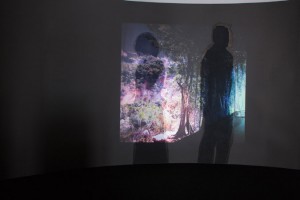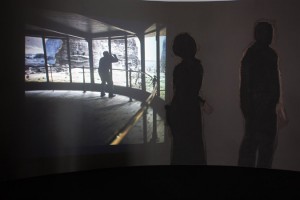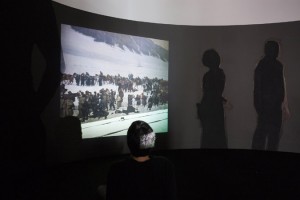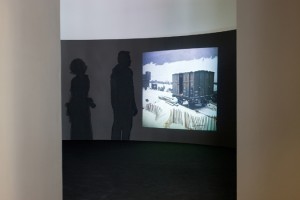Project Arts Centre presents
Curated by Tessa Giblin
Katya Sander’s A Landscape of Known Facts is a newly commissioned artwork that will completely transform the gallery of Project Arts Centre. Sander’s landscape is projected like a lighthouse, a beam that scans the circular room in a slow, continuous, 360degree evolution. Influenced by the early development of cinematic special effects, A Landscape of Known Facts brings to life the history of the panoramic spectacle, while also layering the projected image with iconographic matte painting and textual metaphors. Inside the panorama we eavesdrop on conversations – people who travel, see, purchase tickets, behold spectacles, and consume images.
For the first decades of the nineteenth century and during their renaissance at the end of the same century, panoramas were a popular choice of entertainment and spectacle. Often installed in purpose-built structures for extended periods of time, a visit to a panorama aroused sensations of likeness and deception, sensations that had perhaps never been experienced in such an overtly illusionist setting in the visual history of painting. Designed to present a panoramic view of the world, their battle-scenes and romantically envisaged landscapes drew in the crowds. Visual deceptions engrossed visitors, the Duke of Wellington having been observed chafing with excitement against the barriers during a painted portrayal of the Battle of Sabrao. The enthusiasm of artists and the art establishment was mixed: the exhibitions were dramatically innovative (Sir Joshua Reynolds), excellent teaching tools (John Ruskin) but also the panorama was considered ‘without the pale of Art because its object is deception’* (John Constable). The permanent structures for housing circular panoramas or cycloramas, such as the Regent’s Park Colosseum, thus became a meeting place for spectators across the classes.
The real success story of the panorama lay not in the creation of great lasting works of art, but in the creation of a new public for art and a new conception of what a work of art could be. The only lasting reminder of its impact is the frequency with which we employ its name today.
Scott B. Wilcox*
Legacy issues for panoramas are serious, with few structures surviving into the twentieth century. Painted canvases were cut up to be redistributed on the market, or rolled and stored in unstable conditions, of which very few have survived unscathed.
The artist who first patented the idea of the 360-degree exhibition as la nature à coup d’oeil or nature at a glance was Edinburgh-based Irishman Robert Barker. His 1787 patent focussed on the conditions of viewing, detailing the platform structure, lighting, barriers and other architectural features that could be positioned and constructed to restrict and open the field of vision with the maximum potential for suspending one’s disbelief. The development of cinema marked the end of a mass-fascination with panoramas. The forms of viewing that had begun in the cyclorama constructions had later developed into moving panoramas, complete with stage-lighting and other dramatic effects. The panorama as spectacle was eclipsed by the moving image, but it had also prepared spectators for the moving-screen experience. As prototype cinemas, the panorama asked the spectator to create movement by circling around the interior, believing in the illusion and surrendering oneself to the fantasy of the real.
Like the few modern panoramas that exist today, the action of building a view in order to consume a view was at the heart of the exhibitions. The construction of an image becomes the construction of a space, and to conquer an image you must first consume it.
*Constable, cited by Scott B. Wilcox, ‘Unlimiting the Bounds of Painting’, p.28 in Ralph Hyde, Panoramania!, Barbican Art Gallery, 1988
Biographies
Katya Sander (b. Denmark, lives and works in Berlin and Copenhagen) is an artist, writer and professor whose artistic practice cracks open ways of thinking inside established fields of exchange, be they corporate, public or market-driven, while also investigating the nature of an artwork, and how spectators organise themselves within exhibitions. Sander is part of the collective of artists who produced ‘9 Scripts from a Nation at War’, originally in Documenta 12, and her recent solo exhibitions include ‘Production of Futures – A Science Fiction about Counting’, Künstlerhaus Stuttgart 2008 and ‘The Most Complicated Machines Are Made of Words’, MuMoK – Museum Moderner Kunst, Vienna 2005. Sander’s recent and current participation in group exhibitions include ‘Power Games’ – Ludwig Museum, Budapest 2010, ‘There Is No Alternative’, Konsthall C, Hökarängen, Stockholm 2010, ‘Coming to you Live’ Art in General 2008-09, the 6th Taipei Biennale 2008 and ‘October Salon, 49th edition’, Belgrade Cultural Centre 2008.
Disclaimer
Closed Sundays & Bank Holidays




